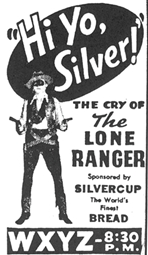

 “The Lone Ranger” “The Lone Ranger”by Boyd Magers With a rousing orchestral rendition of the “William Tell Overture” accompanied by gunshots and hoofbeats came the immortal opening, “A fiery horse with the speed of light, a cloud of dust and a hearty Hi-Yo, Silver! The Lone Ranger with his faithful Indian companion, Tonto, the daring and resourceful masked rider of the plains led the fight for law and order in the early western United States. Nowhere in the pages of history can one find a greater champion of justice. Return with us now to those thrilling days of yesteryear. From out of the past come the thundering hoofbeats of the great horse Silver! The Lone In April 1930 partners George W. Trendle (right) and John King (simply an investor) purchased radio station WGHP in Detroit; the call letters were soon changed to WXYZ. The station was a CBS affiliate but Trendle elected to become independent in January 1932. Now he needed original programming. Believing a Western would be popular, Trendle called together his key personnel to flesh out the idea. Who actually created the Lone Ranger has always been a bone of contention, but Trendle was the instigator and the rest became a group effort. Fran Striker (left), a writer living in Buffalo, NY, The first LR episode was broadcast on January 31, 1933 on WXYZ and eight other stations that formed the Michigan Radio Network. The first 63 30 minute episodes were heard three times a week (Tuesday, Thursday, Saturday), at 9pm. Silvercup Bread became the series’ sponsor as of November 29, 1933 and the broadcast days were now Monday, Wednesday, Friday. WGN, Chicago, WLW, Cincinnati and WOR, Newark, NJ, began carrying “The Lone Ranger” in ‘34. This alliance became the Mutual Broadcasting System as of September 29, 1934. The Ranger now rode the airwaves three times a week at 7:30. Looking for a West Coast outlet, they found it as of January ‘37, in the Don Lee Network which had just lost its CBS affiliation. The Colonial and Yankee networks filled in the Northeast U.S. Various sponsors were added including Merita Bread in the South. Bond Bread became the sponsor on Mutual (2/13/39-5/1/42) until August ‘40. General Mills (Cheerios) became involved as of May ‘41. From May 4, ‘42 til September 3, ‘54, “The Lone Ranger” was heard on the Blue Network which became ABC in 1944. Transcribed repeats aired initially on ABC and later on NBC from September ‘54 til May 18, 1956. George Stenius (later to be known as George Seaton) (left) was the first to portray the
character, incidentally, didn’t join the Ranger until the 12th episode. The Lone Ranger’s nephew, Dan Reid, was portrayed by Ernie Winstanley, Dick Beals and James Lipton. Other parts over the years were fleshed out by Paul Hughes, Jay Michael (Butch Cavendish), John Hodiak and so many more. The program went through several announcers before Fred Foy became the permanent announcer on July 2, 1948. Foy was also Beemer’s understudy but only had to step into the role once (3/29/54) when Beemer had laryngitis. For 3,377 broadcasts over 21 and a half years on radio The Lone Ranger and Tonto brought justice to the West. For over 80 years the legend of The Lone Ranger has endured. He is simply the best known Western hero ever created. (Thanx to Terry Salomonson and John Dunning for their informative research.)
|
|